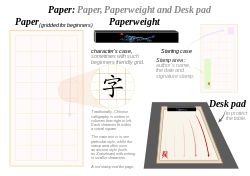|
Chinese school
A Chinese school (simplified Chinese: 中文学校; traditional Chinese: 中文學校; pinyin: zhōngwén xuéxiào; Cantonese Yale: jūngmán hohk'haauh) is a school that is established for the purpose of teaching the varieties of Chinese (in particular, Mandarin and Cantonese), though the purpose can vary to teaching different aspects of Chinese culture such as Chinese art, calligraphy, history and martial arts. The programs can either be an independent institution or a part of an existing educational institution. Many Chinese schools are purposed to preserve traditional Chinese language and culture. In 2007, USA Today dubbed Chinese "... is the new English."[1] A recent trend in 2011 shows that the Chinese government has also provided funding to U.S. school districts with additional funding on top of funding they already receive from the U.S. government. As a result, there has also been concern that the Chinese government may also be infiltrating the education system outside its borders, as some people at a school district in Columbus, Ohio, feel it has done.[2] CurriculumA typical Chinese school curriculum can vary depending on the particular school. However, the Standard Chinese language and various aspects of Chinese culture such as Chinese art, Chinese history and Chinese martial arts are typically included. Chinese language The Chinese language is spoken by nearly 1.2 billion people or about 16% of the world's population. Chinese schools typically teach both written and spoken Chinese. With the growing importance and influence of China's economy globally, Mandarin instruction is gaining popularity in schools in the United States, and has become an increasingly popular subject of study amongst the young in the Western world, as in the UK.[3] One of the teaching tools used widely in Chinese schools is the Pinyin system, also known as the official phonetic system for transcribing the Mandarin pronunciations of Chinese characters into the Latin alphabet which was developed in the 1950s based on earlier forms of romanization. It was published by the Chinese government in 1958 and revised several times.[4] The International Organization for Standardization (ISO) adopted pinyin as an international standard in 1982.[5] Chinese calligraphy Written Chinese as taught in Chinese schools uses methods as defined by the Shūfǎ (書法) from China, which means "the way/method/law of writing".[note 1] Curricula in Chinese writing typically focus on stroke order and repetition. Schools also teach the relationship of words based on their Chinese radicals, as many words come from ideas that relate to a particular topic. Stroke orders of words are also important as they dictate how Chinese words can be found in a Chinese dictionary.[6] Chinese artChinese art is taught in Chinese schools following the techniques as established in Chinese painting. For example:
Chinese martial artsChinese martial arts, sometimes called "kung fu" are a number of fighting styles that have developed over the centuries in China. Chinese schools often offer such programs as part of their curriculum as it is one of the fundamental aspects of Chinese culture. Though some martial art styles may have originated in other parts of Asia such as karate and tae kwon do, they are sometimes taught as though it were part of the Chinese heritage. Major eventsChinese New YearMany Chinese schools put on a Chinese New Year gala as the festival is an important Chinese festival celebrated at the turn of the Chinese calendar. It is also known as the Spring Festival, the literal translation of the modern Chinese name. Chinese New Year celebrations traditionally run from Chinese New Year's Eve, the last day of the last month of the Chinese calendar, to the Lantern Festival on the 15th day of the first month, making the festival the longest in the Chinese calendar. The first day of the New Year falls between January 21 and February 20. See also
Other cultures and languages have similar setups. For example:
Notes
References
External links |
||||||||||||||||||||||
